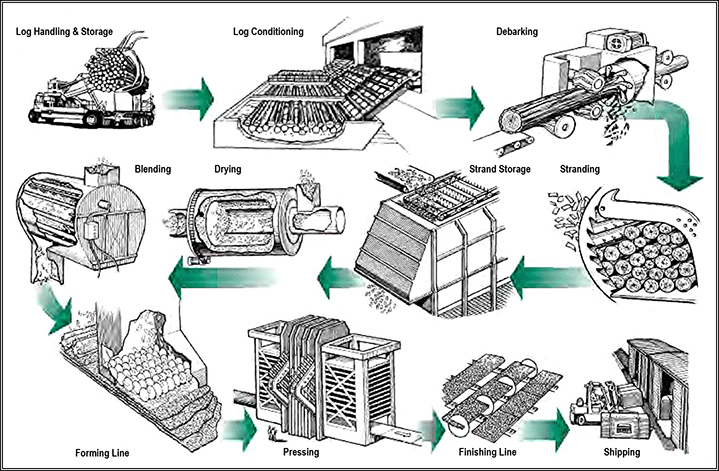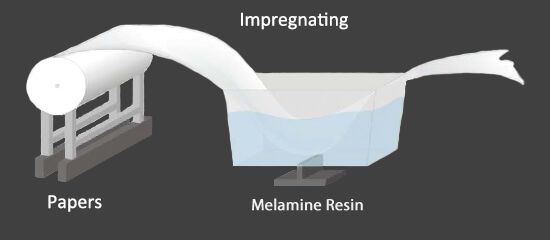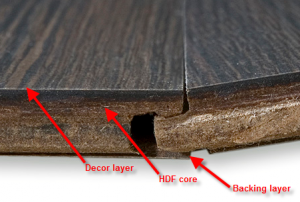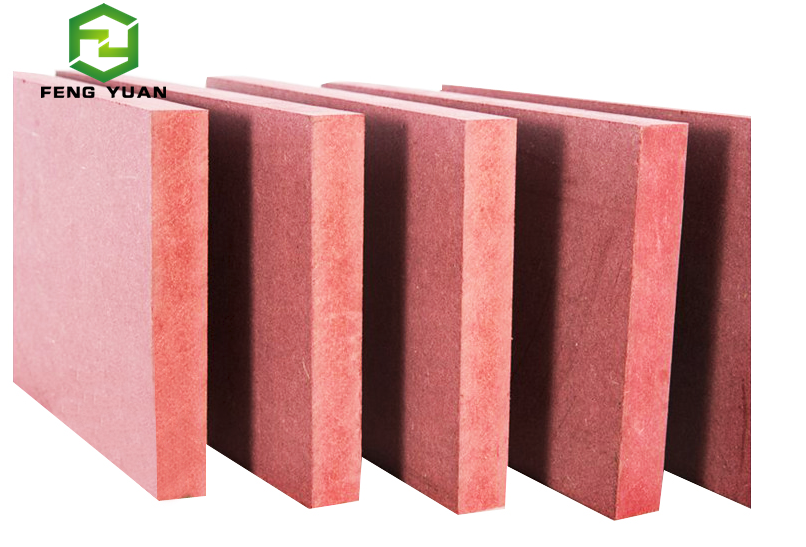This questions has been asked by many persons, now let's introduce MDF here.
MDF , the full name is Medium Density Fiberboard, that’s an inexpensive and durable option for many carpentry projects. Medium-density fiberboard is a versatile building material. It’s cost-effective and good for use on shelving, storage cabinets, and decorative projects. It also has a smooth surface, which is perfect for painting.
MDF is an engineered wood product made by breaking down hardwood or softwood residuals into wood fibres, often in a defibrator, combining it with wax and a resin binder, and forming it into panels by applying high temperature and pressure, it also can be called fiberboard, some high density ≥800,called HDF, but it only have density & thickness difference.
MDF is a versatile building material. It’s cost-effective and good for use on shelving, storage cabinets, and decorative projects. It also has a smooth surface, which is perfect for painting
Yes, the contect of formadehydele can be controlled, the grade can be E1, E0, some grade will be lower than logs.
Advantages of MDF Wood
MDF is inexpensive.
MDF uses recycled wood, which is environmentally-friendly.
Veneers can be attached to MDF to make it look like real wood.
MDF will not expand and contract in the heat and humidity like solid wood can.
MDF is easy to paint in a variety of colors and easier to shape than solid wood.
MDF doesn’t have knots that can make a piece hard to attach.
MDF is resistant to pests, such as termites, due to the chemicals used in its construction.
Disadvantages of MDF Wood
If MDF is chipped or cracked, you cannot repair or cover it easily.
MDF can swell if it touches water.
There’s no natural grain on MDF wood.
Small amounts of formaldehyde may be off-gassed during construction, and it’s less child-friendly than solid wood.
MDF has glue in it that can make it hard to sink certain types of fasteners into it.
If you are interested in MDF,HDF, MELAMINE MDF board, please see more at https://chinafiberboard.com/ This video shows how the continuous machine line produce thin mdf or hdf board. You could find out that our boards are in very good features, and these boards can be used in various places, like furniture and decorations and some you may not imagine before, like computers and cars. We warmly welcome wholesalers, traders, furniture factories, construction projects team to contact us freely. We definitely will provide you with both high quality goods and great service.
Hangzhou Fengyuan Wood Co.,Ltd
Web: https://chinafiberboard.com/
Tel: +86-571-86063713
Whatsapp: +8615868403313
Email: sales@fengyuanwooden.com

OSB , full name is Oriented strand board , after it has been invented, mostly popular used in home ,hotel, baber shop etc. Due to its healthy formaldehyde content, and recommend a good use when in decration.But most of people dont know how to produce it, now let us know this knowledge from above photo & our video. If you want to know more about our OSB products, pls free contact us by email:sales@fengyuanwooden.com.
MDF stands for Medium Density Fibreboard and is made from wood fibres glued together under high heat and pressure. Melamine MDF is melamine paper coated on MDF, have various of colours, E0/E1/E2 glue,it is widely used for furniture, desk, doors , and other decration etc.
The melamine covered MDF core consists of wood fibres. That gives it a flat and smooth surface, dimensional stability, high density, and features that make it easy for processing. You can get it in different thickness, decorative finishes and designs to one or both sides.
It usually widely used for different applications.
Melamine-faced MDF sheets are utilised in a myriad of applications including making:
It is also worth noting that because of its dimensionally stable and smooth surface, melamine covered MDF is also utilised for laminate veneers or decorative wood.
If you are interested in our Thin MDF and HDF board, please see more at https://chinafiberboard.com/ This video shows how the continuous machine line produce thin mdf or hdf board. We warmly welcome wholesalers, traders, furniture factories, construction projects team to contact us freely. We definitely will provide you with both high quality goods and great service.
Hangzhou Fengyuan Wood Co.,Ltd
Web: https://chinafiberboard.com/
Tel: +86-571-86063713
Whatsapp: +8615868403313
Email: sales@fengyuanwooden.com
All the wood based panel which using melamine Laminate technology can be called melamine boards. Common melamine board based with MDF board, particleboard, and plywood. Melamine MDF board, as the name implies, is based of MDF, melamine paper can be various colours, white, black, wood grain,etc.
Usually, when we talk about Melamine boards, we talk about Laminates and baseboards. But in fact is much more complexed. Laminate is generally composed of ① surface paper, ②decorative paper, ③cover paper, and ④bottom paper.
① The surface paper is placed on the top layer of the decorative board. It protects the decorative paper and makes the surface of the board after heating and pressing highly transparent. The board surface is hard and abrasion-resistant. This paper requires good water absorption, white and clean, and transparent after dipping.
② Decorative paper, that is, wood grain paper, is an important part of the decorative board. It has a base color or no base color and is printed into various patterns of decorative paper. It is placed under the surface paper and mainly plays a decorative role. This layer requires Paper has good hiding power, impregnation, and printing performance.
③ Cover paper, also called titanium white paper, is generally placed under decorative paper when manufacturing light-colored decorative boards to prevent the underlying phenolic resin from penetrating the surface. Its main function is to cover the color spots on the surface of the substrate. Therefore, good coverage is required. The above three types of paper were each impregnated with melamine resin.
④ Bottom paper is the base material of the decorative board. It plays a role in the mechanical properties of the board. It is made by impregnating with phenolic resin glue and dried. Several layers can be determined according to the application or the thickness of the decorative board during production.
To turn the papers to laminates, we need to impregnating them in melamine resins, mealmine resin is used for stick the paper on surface of MDF.

when we had Melamine Laminates, then use a hot press machine to laminated it with MDF Board.

This the process how the melamine MDF board be produced.The Impregnating Process normally finished by the laminates factory, then we buy melamine laminates from them and produce melamine Paper
You can also view the above video to see how it works.
If you are interested in melamine melamine MDF , please see more at https://chinafiberboard.com/
We warmly welcome wholesalers, traders, furniture factories, construction projects team to contact us freely.
We definitely will provide you with both high quality goods and great service.
Hangzhou Fengyuan Wood Co.,Ltd
Web: https://chinafiberboard.com/
Tel: +86-571-86063713
Whats app: +8615868403313
Email: sales@fengyuanwooden.com
One of the key areas to ask about when shopping for laminate and engineered wood floors is the core layer, which we talk about a bit on our 5 Things You Need To Know Before You Buy Laminate Flooring. The materials typically used in the making of a core layer is high-density fiberboard (HDF) and medium-density fiberboard (MDF). Given that it is an important aspect when it comes to the anatomy of a floor, and important when you’re buying floors, I thought it made sense to talk about it a bit.
Fiberboard is a wood byproduct, known as an engineered wood product because raw materials are taken and processed into a versatile and durable material. It’s used in flooring as core material, of course. But, it’s also used for furniture manufacturing, designed not to split or crack.
Fiberboard is made through a compression process, where wood fibers are bonded together, specifically for the use of backing or of reinforcing a veneer, and most often with a resin to keep it stable. On laminate flooring and engineered hardwood floors, the fiberboard core are sandwiched between the decor layer or veneer layer, and the backing layer.
Take a look:

HDF is MDF are made in a similar process, although the compression levels are in a slightly lower range with MDF from 600-800 kg/m3. HDF is processed in a range from 600-1450 kg/M3. Fiberboard cores are checked for emissions levels, both when they’re manufactured, and afterward too before they’re shipped as product. This is mainly due to the use of resins and glue that are used to bind the materials, and the importance placed on reducing off-gassing as much as possible.
One of the pieces of advice is to always choose HDF when shopping for laminate floors, if you can. The ressistance to moisture, and to shrinkage and expansion in HDF is much higher. This makes for a more stable core, which is the job of the core in any case – to give you a more stable floor overall. MDF will still serve you, of course. But, HDF is preferable for better performance.
What is Hot pressing for hardboard? This is the questions we asked mostly from our clients, let's discuss it together.
The hot-pressed wet-process method produces a hard-fiber board with a pressure of 5 MPa and a dry method of 7 MPa. Above this pressure, the bending strength is reduced. The pressure required for the semi-dry method is between the two, at 6 MPa. The wet-formed slab is pressed into a hard fiberboard at a pressure of up to 10 MPa. The temperature used in the wet pressing method is 200 to 220 °C.
There is no drying stage when dry pressing, the temperature is based on the rapid curing of the adhesive, generally 180 ~ 200 ° C; when using hardwood as raw material, the hot pressing temperature can be appropriately increased, up to 260 ° C. The semi-dry hot pressing temperature should not exceed 200 ° C to prevent the melting of lignin and sugar hydrolysis coking in the slab, so that the strength of the product is significantly reduced.
The temperature required to produce a hard board by wet drying is 230 to 250 °C. During the hot pressing process, the temperature difference between the surface layer and the core layer of the slab may occur, and the temperature difference of the core layer of the medium-density slab having a large thickness may reach 40 to 60 ° C, which affects the curing rate of the core resin. Conventional heating and high frequency heating can be used to eliminate temperature differences and shorten the hot pressing cycle.
After hot processing, hardboard, mdf, plywood will be have a good quality & stable technical nature.


This new colour is custom-made, regular for furniture, cabinet, etc.
Colour is light beige,light grey, can be laminated on mdf, HMR mdf, etc.
Shipment is suit for bulk shipping ,container shipping/
Furniture made from solid wood is typically thought of as beautiful, timeless and high quality. Whether it’s oak, pine or maple, there are plenty of choices when it comes to using wood for furniture.
In comparison, MDF (Medium Density Fiber-Board) is made with recycled timer and fiber materials, mixed with resin-based glue and compacted very tightly together.
Typically, MDF is seen as a cheaper alternative to solid wood and is often perceived to be lower in quality. However, in recent years there has been a rapid resurgence in flat-pack furniture being manufactured with MDF. This is largely due to the lower material costs, but also because it’s easy to store compactly.
So, with advantages and disadvantages for both solid wood and MDF, which is the better option?

Cost
MDF’s core ingredient is sawdust and small chippings of other timbers. These are all collected waste products from the machining process which makes the material cost much lower than plywood and solid wood.
Size variety
MDF sheets are available off-the-shelf in over 100 different thicknesses, starting from 2mm and going right up to 60mm. The wide-ranging number of options available makes it very easy to get the thickness of “wood” that is required for the application at hand.
Ugly raw material
Solid wood is renowned for its astounding natural beauty. MDF is not the most attractive natural colour and lacks the character and features found in solid wood and plywood.
Less warping issues
Unlike solid wood, MDF will remain strong in areas where there is high humidity and moisture. This is because MDF is able to consistently shrink and expand without the different parts of the grain working against each other.
Consistent material
MDF doesn’t have a directional grain like plywood and solid wood which makes it ideal if you’re cutting intricate details or moulding; other materials would splinter or the cut will not be as smooth.
Smooth surface and cuts
MDF is pressed extremely compact during the manufacturing process with large steel plates, which makes the overall sheet extremely flat and smooth. This makes MDF ideal for painting, laminating or attaching veneers. Once sheets are cut to size, the edges remain smooth, whereas on solid wood or plywood the edges can splinter or have voids due to the natural knots and grain in the wood。
Weak material
MDF lacks the directional grain that gives solid wood and plywood its strength and structural integrity. Even though a lot of shelving and cabinets are remade from MDF, they require a solid timber frame to provide support or must be fixed in a way to ensure it does not sag over time.
Cracks and splits
You have to be extremely careful when screwing into MDF as it’s liable to crack or split across its fibers. Pilot holes are essential before screwing into MDF to make room for the screw and reduce the chances of the material splitting – although it’s important to note that MDF can still split even if you use a regular screw. Since regular wood screws tapered shape will make MDF split, a straight sharked screw is required.
Restrictions on finish
If you’re wanting to match an existing furniture finish with a wood stain, it’s best to not use MDF. MDF will soak up all of the liquid and not give the desired colour effect. It’s best to use this material if the plan is to have it painted.
Contains VOC’s
The glue that holds all of the fibres together contains formaldehyde. When it’s cut, sanded or machined, it kicks out a lot of dust that can cause irritation to the lungs and eyes. Long term effects can include lung, nose and throat cancer.
Copyright © 2024. Hangzhou Fengyuan Wood Co.,Ltd All rights reserved.